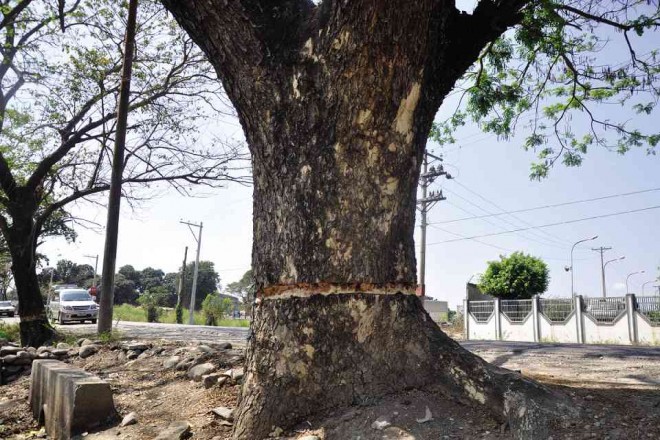Agencies liable, says provincial board

SLOW DEATH These trees lining the MacArthur Highway in Binalonan town in Pangasinan province have been marked for cutting to make way for a road-widening project. WILLIE LOMIBAO/CONTRIBUTOR
LINGAYEN, Pangasinan—The provincial board on Monday said government agencies behind the cutting of more than 1,000 trees along the Manila North Road (MacArthur Highway) in Pangasinan might be sued for violating a 1963 law prohibiting the destruction of trees along public roads.
Members of the board held a session on Monday to address the controversy.
One of them, Alfonso Bince, said the board was never consulted about the road-widening project that required the cutting of trees lining the highway from Rosales to Sison towns.
Bince cited Republic Act No. 3571, which prohibits the “cutting, destroying or injuring of planted or growing trees, flowering plants and shrubs or plants of scenic value along public roads, in plazas, parks, school premises or in any other public ground.”
Last year, the Department of Environment and Natural Resources (DENR) granted a special permit to the Department of Public Works and Highways (DPWH) to cut or remove by earth balling 1,829 trees along the Manila North Road, which traverses Rosales, Villasis, Binalonan, Pozorrubio and Sison towns, and Urdaneta City.
Article continues after this advertisementFew complaints emerged in Pangasinan regarding the massive tree cutting until January, when tourists on their way to Baguio City noticed the fallen trees, stumps and trees “girdled” or marked for cutting.
Article continues after this advertisementGirdling
“We did not expect the girdling to happen,” Leduina Co, provincial environment and natural resources officer, told the board. Girdling a tree means peeling off thick sections of the trunk’s bark to stop nutrients from reaching the upper sections.
An online protest was launched, while “running priest” Robert Reyes, one of the vocal critics, led a protest run in eastern Pangasinan recently.
Co explained that the cutting of trees along the national road was exempted from RA 3571, which, she added, President Aquino considered “an impact project.”
The DPWH followed procedures when it applied for a special permit last year and had undertaken consultations in towns where the condemned trees stand, she said.
But it failed to comply with the 90-day period for removing the trees. The permit expired on Feb. 4.
The board was told that 770 trees had remained standing along the sections of the highway. The DPWH and the DENR will spare 225 of the trees after the agencies reassessed the road-widening plans on Feb. 21.
Fernando Estrada, Urdaneta acting community environment and natural resources officer, said the DENR required the DPWH to plant 100 seedlings for every tree felled, but the latter needed to wait for the rainy season to comply.
Emmanuel Diaz, district engineer, acknowledged that 99 tree saplings in Villasis and eight saplings in Rosales identified for earth balling were cut because the DPWH had no earth-balling equipment.
Earth balling
“We tried earth balling [using a] backhoe. But we could not properly deliver the saplings to the relocation area, which is 40 kilometers away,” Diaz told the provincial board.
“The other saplings had since [become] full-grown trees. Other saplings are already enclosed by concrete pavements. And [it came to a point when] it was no longer advisable to [perform the earth balling] because it was not the [proper] season to [do so],” he said.
“That’s the reason why in our memorandum of agreement with the DENR, we will be replacing … [a total of] 1,926 [trees],” Diaz said. A 366-hectare area in San Manuel town has been identified as the site for the planting of some 192,600 trees when the rainy season begins in June.
Diaz also told the board members that his office had tried to save as many trees that it could.
“When we submitted our request, we have already undertaken a preliminary detailed engineering and we tried our best to bypass or minimize the loss of trees. We studied the possibility of taking bypasses,” he said.
In its initial inventory, he said, the DPWH identified some 3,400 trees that would have been displaced by the project, but it managed to trim it down to 1,829 trees.
The DPWH sought the extension of its tree-cutting permit, but an environmental group opposed it.
“Widening the road would reduce travel time,” Diaz said. “Reduction of travel time means reduction of carbon emission. So, by widening, we are reducing carbon emission,” he said.